Impact of Cyberattacks on National Governance: A Detailed Report
VerifiedAdded on 2021/05/31
|9
|1731
|34
Report
AI Summary
This report provides a detailed analysis of the failures in national governance, primarily focusing on the impact of cyberattacks on economies and urbanization across the globe. It explores how cyberattacks have become instruments in geopolitics and economics, affecting both developed and developing countries. The report highlights the vulnerabilities of national infrastructures and the increasing sophistication of cybercriminals, emphasizing the need for international collaboration and utilization of technological advancements to combat cybercrime. It also addresses the challenges faced by developing nations in the context of rapid urbanization and their increased exposure to cyber threats. Furthermore, the report includes a risk register to identify and mitigate potential risks associated with cyberattacks and proposes action plans for effective cybercrime management, advocating for integrated capabilities and proper technology utilization to ensure national governance stability.
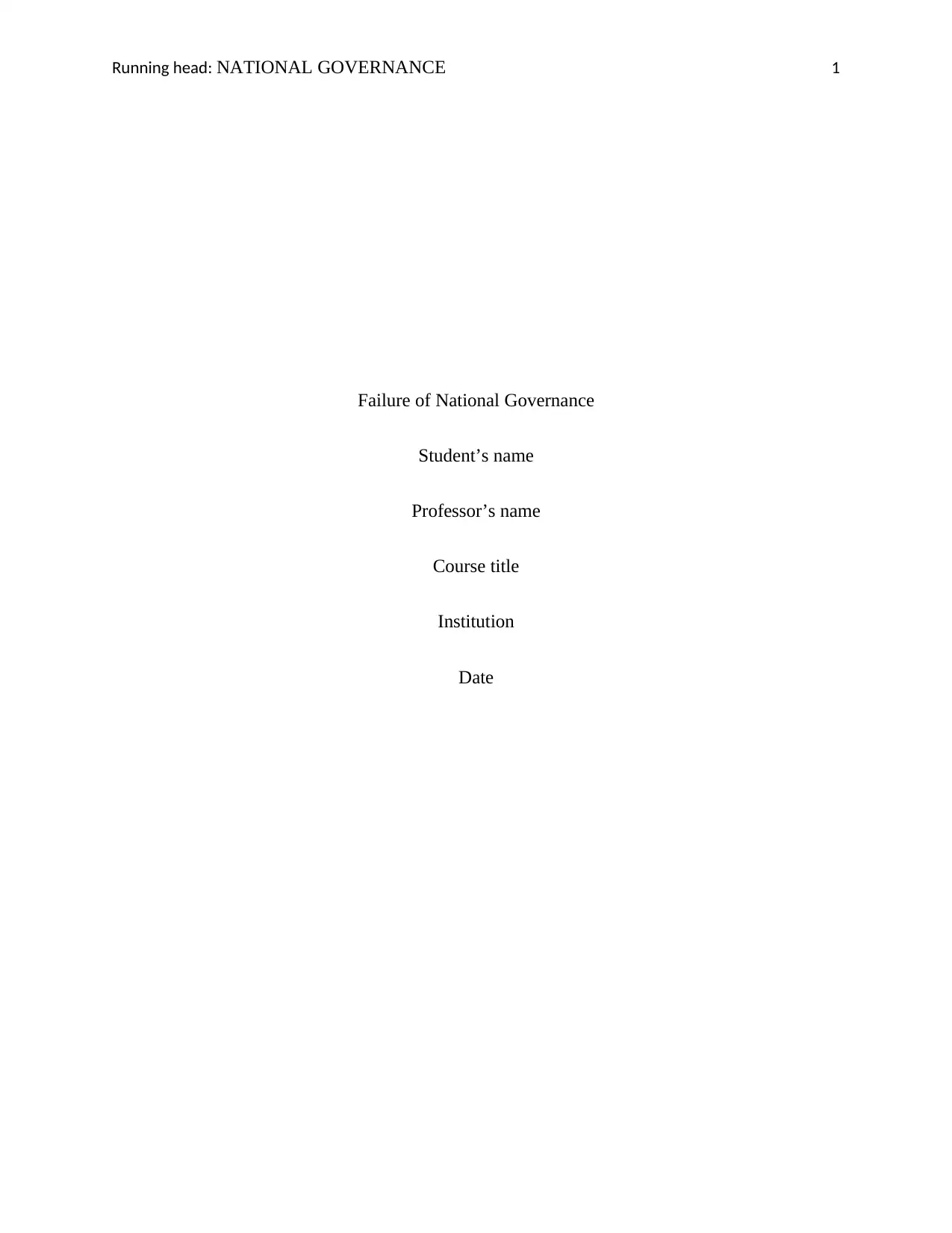
Running head: NATIONAL GOVERNANCE 1
Failure of National Governance
Student’s name
Professor’s name
Course title
Institution
Date
Failure of National Governance
Student’s name
Professor’s name
Course title
Institution
Date
Paraphrase This Document
Need a fresh take? Get an instant paraphrase of this document with our AI Paraphraser
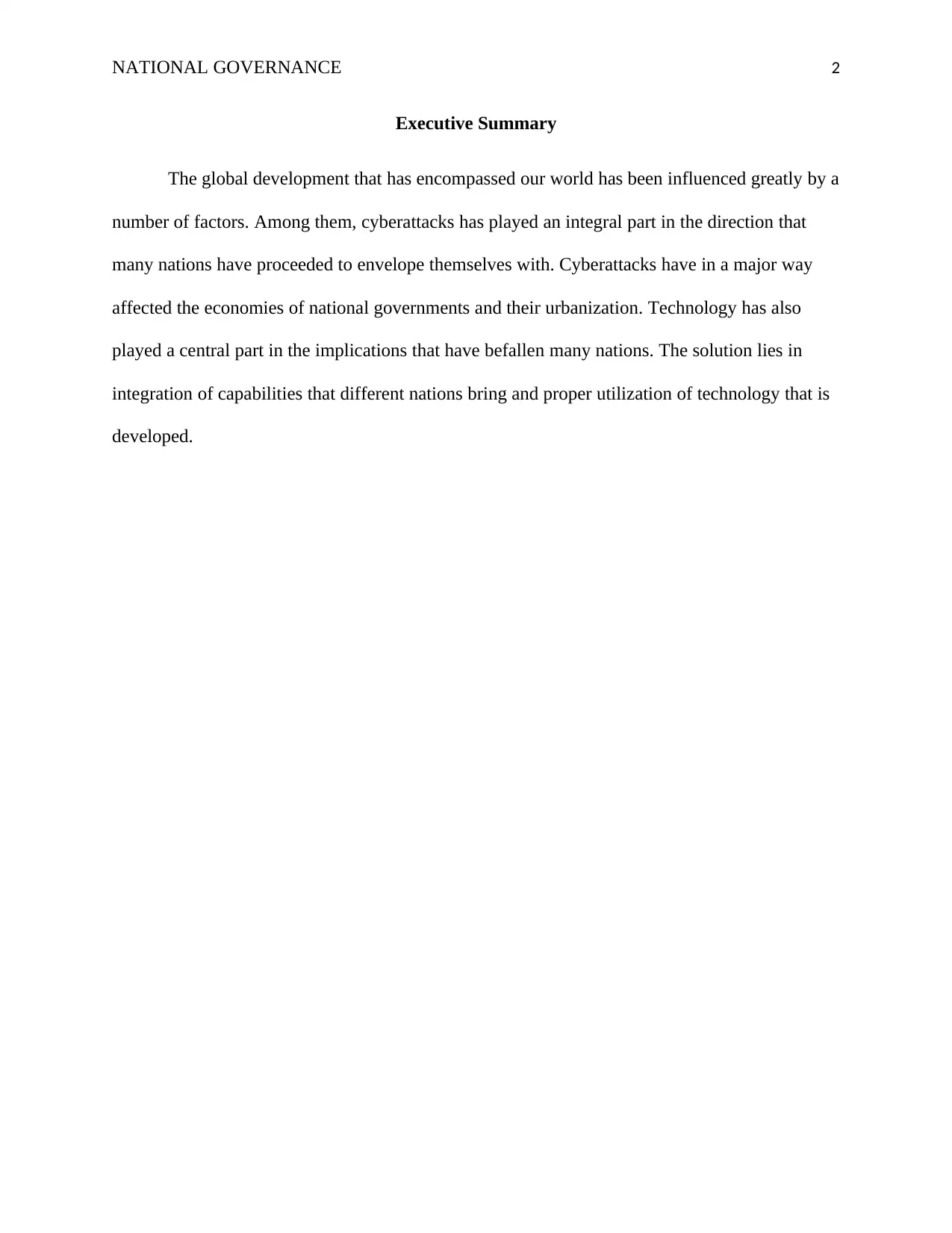
NATIONAL GOVERNANCE 2
Executive Summary
The global development that has encompassed our world has been influenced greatly by a
number of factors. Among them, cyberattacks has played an integral part in the direction that
many nations have proceeded to envelope themselves with. Cyberattacks have in a major way
affected the economies of national governments and their urbanization. Technology has also
played a central part in the implications that have befallen many nations. The solution lies in
integration of capabilities that different nations bring and proper utilization of technology that is
developed.
Executive Summary
The global development that has encompassed our world has been influenced greatly by a
number of factors. Among them, cyberattacks has played an integral part in the direction that
many nations have proceeded to envelope themselves with. Cyberattacks have in a major way
affected the economies of national governments and their urbanization. Technology has also
played a central part in the implications that have befallen many nations. The solution lies in
integration of capabilities that different nations bring and proper utilization of technology that is
developed.
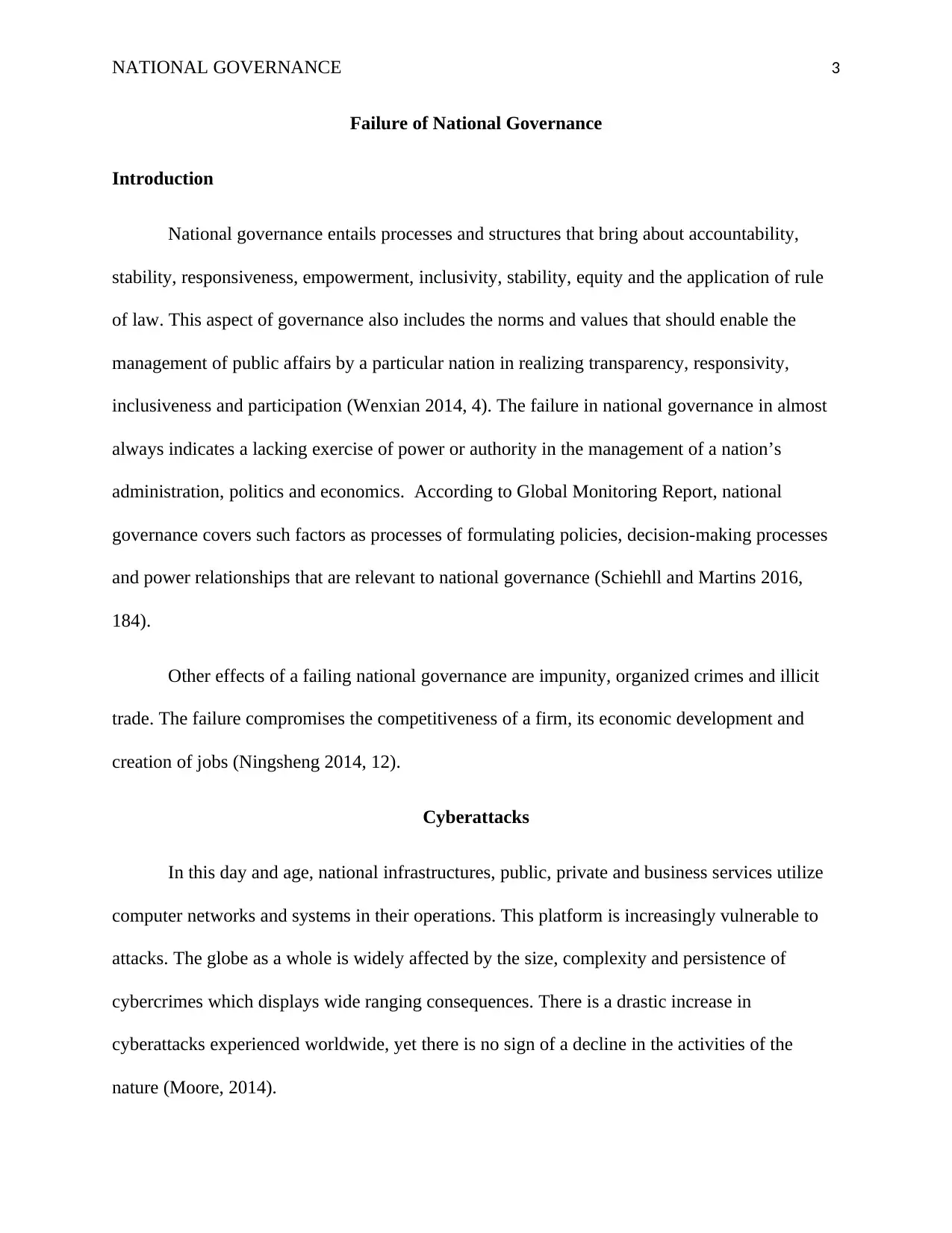
NATIONAL GOVERNANCE 3
Failure of National Governance
Introduction
National governance entails processes and structures that bring about accountability,
stability, responsiveness, empowerment, inclusivity, stability, equity and the application of rule
of law. This aspect of governance also includes the norms and values that should enable the
management of public affairs by a particular nation in realizing transparency, responsivity,
inclusiveness and participation (Wenxian 2014, 4). The failure in national governance in almost
always indicates a lacking exercise of power or authority in the management of a nation’s
administration, politics and economics. According to Global Monitoring Report, national
governance covers such factors as processes of formulating policies, decision-making processes
and power relationships that are relevant to national governance (Schiehll and Martins 2016,
184).
Other effects of a failing national governance are impunity, organized crimes and illicit
trade. The failure compromises the competitiveness of a firm, its economic development and
creation of jobs (Ningsheng 2014, 12).
Cyberattacks
In this day and age, national infrastructures, public, private and business services utilize
computer networks and systems in their operations. This platform is increasingly vulnerable to
attacks. The globe as a whole is widely affected by the size, complexity and persistence of
cybercrimes which displays wide ranging consequences. There is a drastic increase in
cyberattacks experienced worldwide, yet there is no sign of a decline in the activities of the
nature (Moore, 2014).
Failure of National Governance
Introduction
National governance entails processes and structures that bring about accountability,
stability, responsiveness, empowerment, inclusivity, stability, equity and the application of rule
of law. This aspect of governance also includes the norms and values that should enable the
management of public affairs by a particular nation in realizing transparency, responsivity,
inclusiveness and participation (Wenxian 2014, 4). The failure in national governance in almost
always indicates a lacking exercise of power or authority in the management of a nation’s
administration, politics and economics. According to Global Monitoring Report, national
governance covers such factors as processes of formulating policies, decision-making processes
and power relationships that are relevant to national governance (Schiehll and Martins 2016,
184).
Other effects of a failing national governance are impunity, organized crimes and illicit
trade. The failure compromises the competitiveness of a firm, its economic development and
creation of jobs (Ningsheng 2014, 12).
Cyberattacks
In this day and age, national infrastructures, public, private and business services utilize
computer networks and systems in their operations. This platform is increasingly vulnerable to
attacks. The globe as a whole is widely affected by the size, complexity and persistence of
cybercrimes which displays wide ranging consequences. There is a drastic increase in
cyberattacks experienced worldwide, yet there is no sign of a decline in the activities of the
nature (Moore, 2014).
⊘ This is a preview!⊘
Do you want full access?
Subscribe today to unlock all pages.

Trusted by 1+ million students worldwide

NATIONAL GOVERNANCE 4
Cyberattacks are more pronounced in the developed countries. There are a number of
public sector bodies in some nationals that have been hugely disrupted by cyberattacks such as
Japan and US. The nature of cyberattack is basically constantly evolving which makes it such a
complex matter to solve. Numerous number of exploits and malware are currently free and
available on the internet. In many instances there have been threats that are working together in
trade, developments and business practices (Snyder 2017).
Geopolitics and Economics
The digital evolution has brought with it increased global connectivity, marketing and
innovation. The effects also extend to negative outcomes which have impacted many a nation up
to date. These attacks have developed to become instruments in geopolitics and economics (Holt,
Burruss and Bossler 2015).
There are countless initiatives that have involved leveraging of the capabilities of cyber
criminals and potential ones in inappropriate defense or advancement of national interests. There
are instances where states work against others to their advantage through use of individuals
proficient in cybercrime to gain unauthorized access to other nationals. The advantage is mainly
gained in economic terms. While the complete summation of the gains made by the cyber
criminals is more or less difficult to adequately compute, cybercrimes have cost the Australian
government over approximately $4.5 billion annually. The rise in cybercrime has led to more
monetization and taking advantage of the global market (Glasser and Taneja 2014, 398).
The Australian Security Intelligence Organization (ASIO) revealed that the magnanimity
of the maliciousness in cyberattacks has overburdened the government in the investigation of the
espionage and the interference in the affairs of the national government by other nations. This
Cyberattacks are more pronounced in the developed countries. There are a number of
public sector bodies in some nationals that have been hugely disrupted by cyberattacks such as
Japan and US. The nature of cyberattack is basically constantly evolving which makes it such a
complex matter to solve. Numerous number of exploits and malware are currently free and
available on the internet. In many instances there have been threats that are working together in
trade, developments and business practices (Snyder 2017).
Geopolitics and Economics
The digital evolution has brought with it increased global connectivity, marketing and
innovation. The effects also extend to negative outcomes which have impacted many a nation up
to date. These attacks have developed to become instruments in geopolitics and economics (Holt,
Burruss and Bossler 2015).
There are countless initiatives that have involved leveraging of the capabilities of cyber
criminals and potential ones in inappropriate defense or advancement of national interests. There
are instances where states work against others to their advantage through use of individuals
proficient in cybercrime to gain unauthorized access to other nationals. The advantage is mainly
gained in economic terms. While the complete summation of the gains made by the cyber
criminals is more or less difficult to adequately compute, cybercrimes have cost the Australian
government over approximately $4.5 billion annually. The rise in cybercrime has led to more
monetization and taking advantage of the global market (Glasser and Taneja 2014, 398).
The Australian Security Intelligence Organization (ASIO) revealed that the magnanimity
of the maliciousness in cyberattacks has overburdened the government in the investigation of the
espionage and the interference in the affairs of the national government by other nations. This
Paraphrase This Document
Need a fresh take? Get an instant paraphrase of this document with our AI Paraphraser
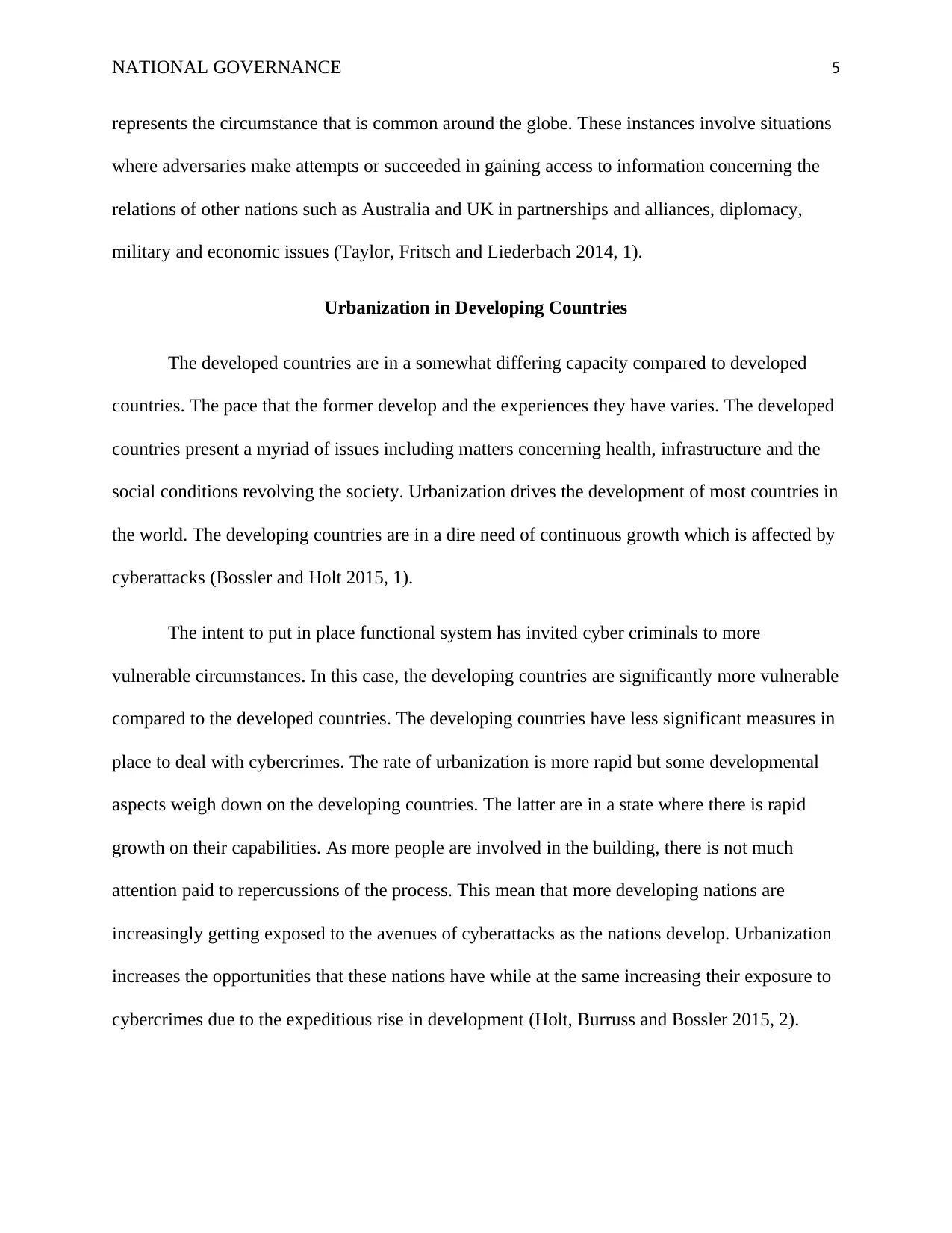
NATIONAL GOVERNANCE 5
represents the circumstance that is common around the globe. These instances involve situations
where adversaries make attempts or succeeded in gaining access to information concerning the
relations of other nations such as Australia and UK in partnerships and alliances, diplomacy,
military and economic issues (Taylor, Fritsch and Liederbach 2014, 1).
Urbanization in Developing Countries
The developed countries are in a somewhat differing capacity compared to developed
countries. The pace that the former develop and the experiences they have varies. The developed
countries present a myriad of issues including matters concerning health, infrastructure and the
social conditions revolving the society. Urbanization drives the development of most countries in
the world. The developing countries are in a dire need of continuous growth which is affected by
cyberattacks (Bossler and Holt 2015, 1).
The intent to put in place functional system has invited cyber criminals to more
vulnerable circumstances. In this case, the developing countries are significantly more vulnerable
compared to the developed countries. The developing countries have less significant measures in
place to deal with cybercrimes. The rate of urbanization is more rapid but some developmental
aspects weigh down on the developing countries. The latter are in a state where there is rapid
growth on their capabilities. As more people are involved in the building, there is not much
attention paid to repercussions of the process. This mean that more developing nations are
increasingly getting exposed to the avenues of cyberattacks as the nations develop. Urbanization
increases the opportunities that these nations have while at the same increasing their exposure to
cybercrimes due to the expeditious rise in development (Holt, Burruss and Bossler 2015, 2).
represents the circumstance that is common around the globe. These instances involve situations
where adversaries make attempts or succeeded in gaining access to information concerning the
relations of other nations such as Australia and UK in partnerships and alliances, diplomacy,
military and economic issues (Taylor, Fritsch and Liederbach 2014, 1).
Urbanization in Developing Countries
The developed countries are in a somewhat differing capacity compared to developed
countries. The pace that the former develop and the experiences they have varies. The developed
countries present a myriad of issues including matters concerning health, infrastructure and the
social conditions revolving the society. Urbanization drives the development of most countries in
the world. The developing countries are in a dire need of continuous growth which is affected by
cyberattacks (Bossler and Holt 2015, 1).
The intent to put in place functional system has invited cyber criminals to more
vulnerable circumstances. In this case, the developing countries are significantly more vulnerable
compared to the developed countries. The developing countries have less significant measures in
place to deal with cybercrimes. The rate of urbanization is more rapid but some developmental
aspects weigh down on the developing countries. The latter are in a state where there is rapid
growth on their capabilities. As more people are involved in the building, there is not much
attention paid to repercussions of the process. This mean that more developing nations are
increasingly getting exposed to the avenues of cyberattacks as the nations develop. Urbanization
increases the opportunities that these nations have while at the same increasing their exposure to
cybercrimes due to the expeditious rise in development (Holt, Burruss and Bossler 2015, 2).
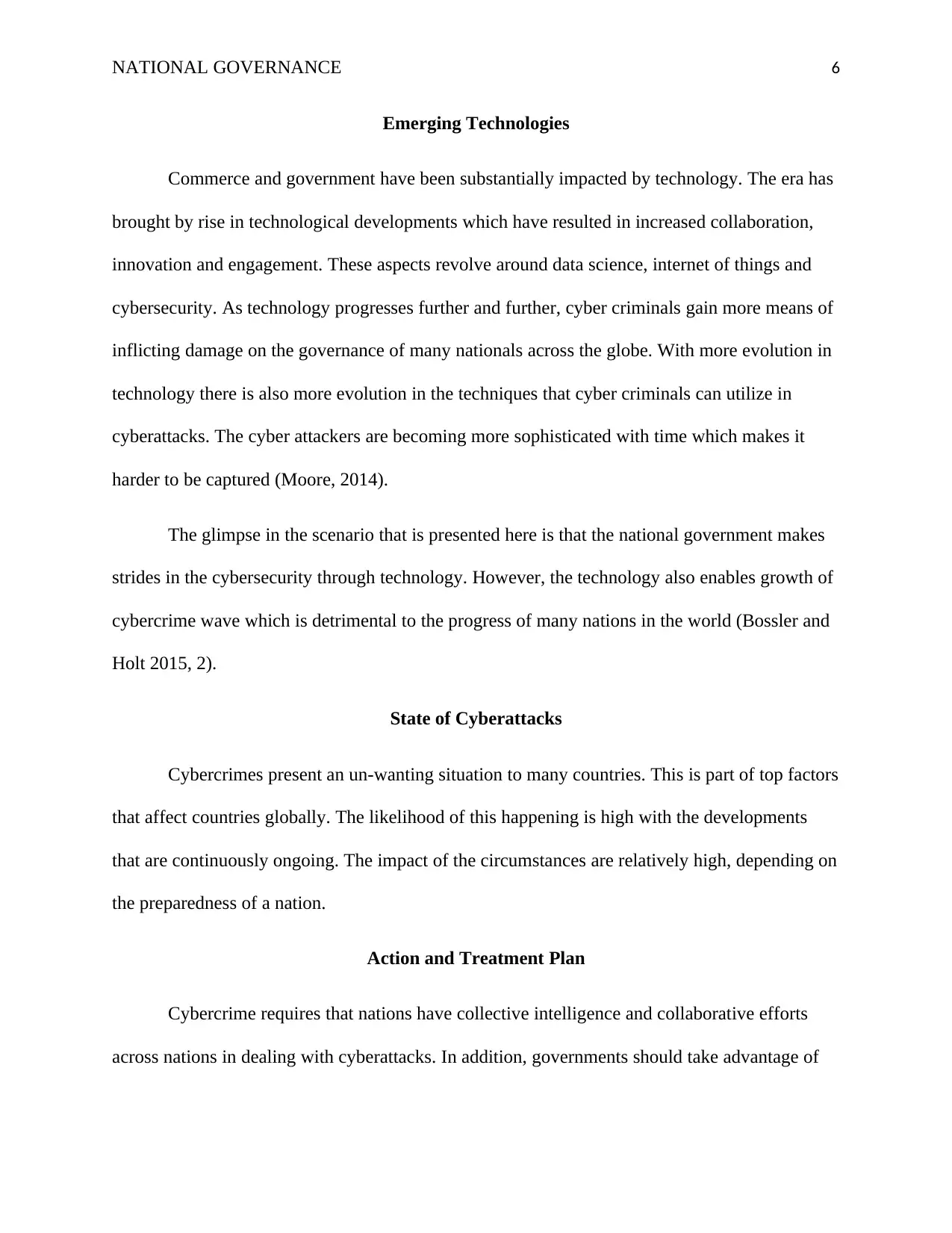
NATIONAL GOVERNANCE 6
Emerging Technologies
Commerce and government have been substantially impacted by technology. The era has
brought by rise in technological developments which have resulted in increased collaboration,
innovation and engagement. These aspects revolve around data science, internet of things and
cybersecurity. As technology progresses further and further, cyber criminals gain more means of
inflicting damage on the governance of many nationals across the globe. With more evolution in
technology there is also more evolution in the techniques that cyber criminals can utilize in
cyberattacks. The cyber attackers are becoming more sophisticated with time which makes it
harder to be captured (Moore, 2014).
The glimpse in the scenario that is presented here is that the national government makes
strides in the cybersecurity through technology. However, the technology also enables growth of
cybercrime wave which is detrimental to the progress of many nations in the world (Bossler and
Holt 2015, 2).
State of Cyberattacks
Cybercrimes present an un-wanting situation to many countries. This is part of top factors
that affect countries globally. The likelihood of this happening is high with the developments
that are continuously ongoing. The impact of the circumstances are relatively high, depending on
the preparedness of a nation.
Action and Treatment Plan
Cybercrime requires that nations have collective intelligence and collaborative efforts
across nations in dealing with cyberattacks. In addition, governments should take advantage of
Emerging Technologies
Commerce and government have been substantially impacted by technology. The era has
brought by rise in technological developments which have resulted in increased collaboration,
innovation and engagement. These aspects revolve around data science, internet of things and
cybersecurity. As technology progresses further and further, cyber criminals gain more means of
inflicting damage on the governance of many nationals across the globe. With more evolution in
technology there is also more evolution in the techniques that cyber criminals can utilize in
cyberattacks. The cyber attackers are becoming more sophisticated with time which makes it
harder to be captured (Moore, 2014).
The glimpse in the scenario that is presented here is that the national government makes
strides in the cybersecurity through technology. However, the technology also enables growth of
cybercrime wave which is detrimental to the progress of many nations in the world (Bossler and
Holt 2015, 2).
State of Cyberattacks
Cybercrimes present an un-wanting situation to many countries. This is part of top factors
that affect countries globally. The likelihood of this happening is high with the developments
that are continuously ongoing. The impact of the circumstances are relatively high, depending on
the preparedness of a nation.
Action and Treatment Plan
Cybercrime requires that nations have collective intelligence and collaborative efforts
across nations in dealing with cyberattacks. In addition, governments should take advantage of
⊘ This is a preview!⊘
Do you want full access?
Subscribe today to unlock all pages.

Trusted by 1+ million students worldwide
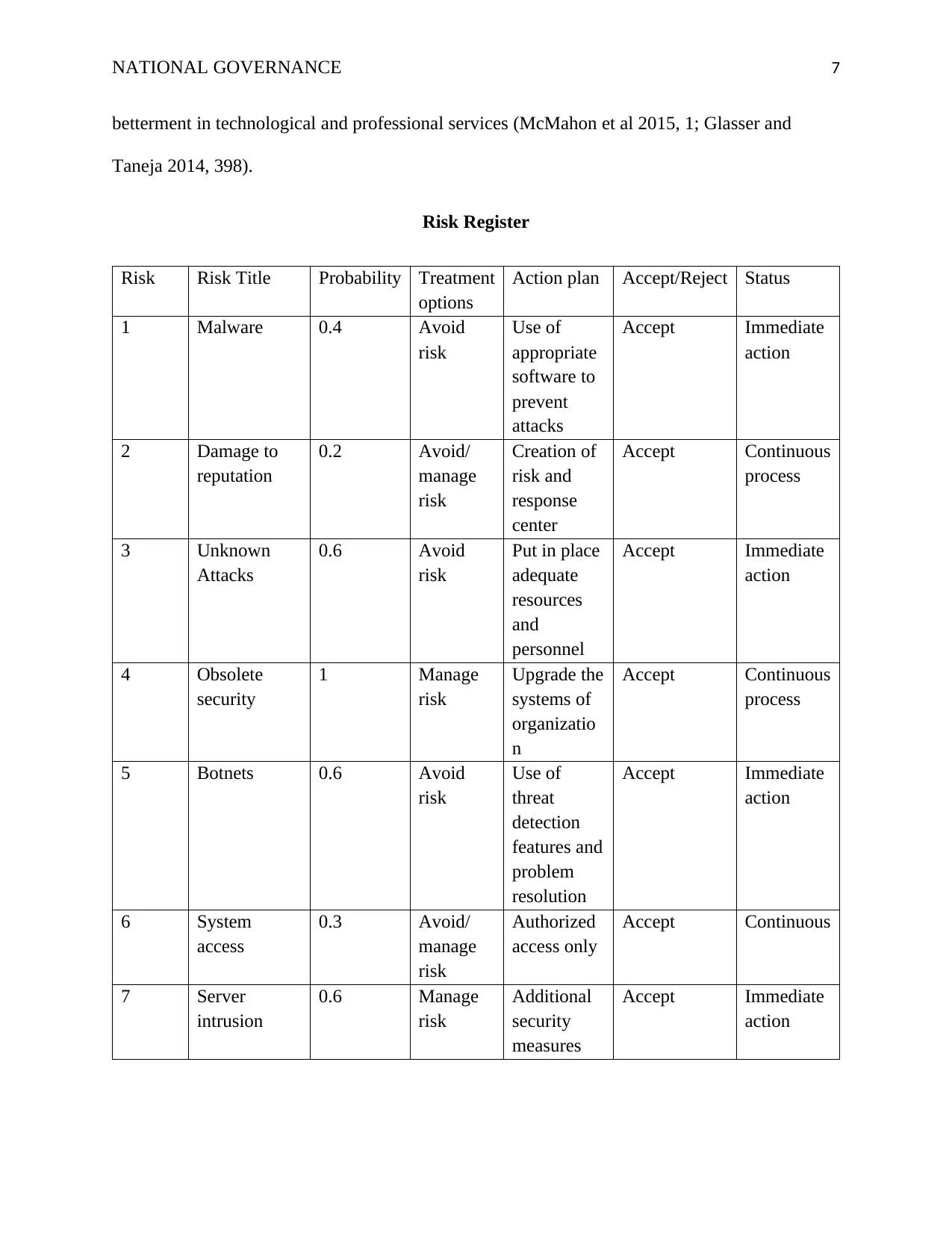
NATIONAL GOVERNANCE 7
betterment in technological and professional services (McMahon et al 2015, 1; Glasser and
Taneja 2014, 398).
Risk Register
Risk Risk Title Probability Treatment
options
Action plan Accept/Reject Status
1 Malware 0.4 Avoid
risk
Use of
appropriate
software to
prevent
attacks
Accept Immediate
action
2 Damage to
reputation
0.2 Avoid/
manage
risk
Creation of
risk and
response
center
Accept Continuous
process
3 Unknown
Attacks
0.6 Avoid
risk
Put in place
adequate
resources
and
personnel
Accept Immediate
action
4 Obsolete
security
1 Manage
risk
Upgrade the
systems of
organizatio
n
Accept Continuous
process
5 Botnets 0.6 Avoid
risk
Use of
threat
detection
features and
problem
resolution
Accept Immediate
action
6 System
access
0.3 Avoid/
manage
risk
Authorized
access only
Accept Continuous
7 Server
intrusion
0.6 Manage
risk
Additional
security
measures
Accept Immediate
action
betterment in technological and professional services (McMahon et al 2015, 1; Glasser and
Taneja 2014, 398).
Risk Register
Risk Risk Title Probability Treatment
options
Action plan Accept/Reject Status
1 Malware 0.4 Avoid
risk
Use of
appropriate
software to
prevent
attacks
Accept Immediate
action
2 Damage to
reputation
0.2 Avoid/
manage
risk
Creation of
risk and
response
center
Accept Continuous
process
3 Unknown
Attacks
0.6 Avoid
risk
Put in place
adequate
resources
and
personnel
Accept Immediate
action
4 Obsolete
security
1 Manage
risk
Upgrade the
systems of
organizatio
n
Accept Continuous
process
5 Botnets 0.6 Avoid
risk
Use of
threat
detection
features and
problem
resolution
Accept Immediate
action
6 System
access
0.3 Avoid/
manage
risk
Authorized
access only
Accept Continuous
7 Server
intrusion
0.6 Manage
risk
Additional
security
measures
Accept Immediate
action
Paraphrase This Document
Need a fresh take? Get an instant paraphrase of this document with our AI Paraphraser
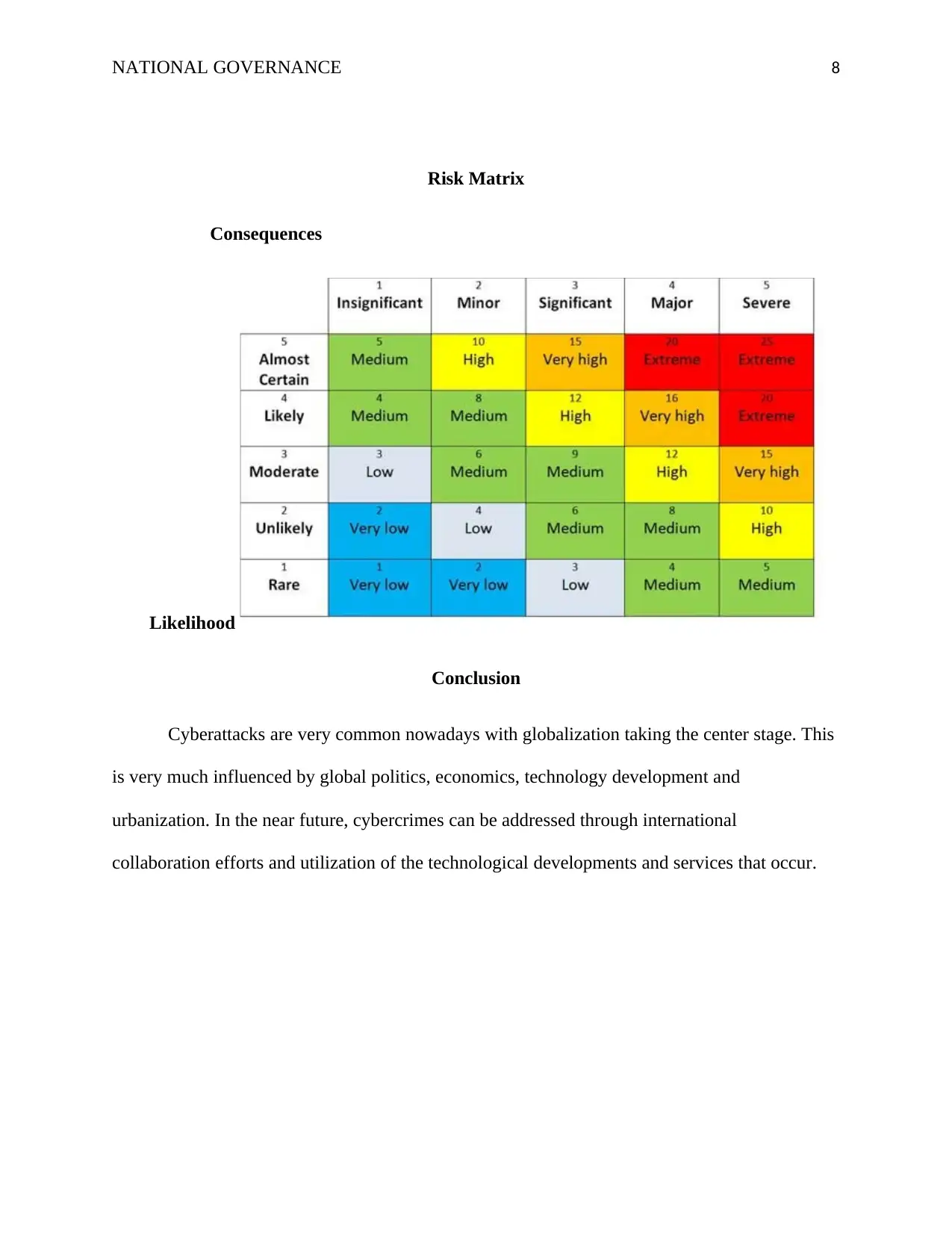
NATIONAL GOVERNANCE 8
Risk Matrix
Consequences
Likelihood
Conclusion
Cyberattacks are very common nowadays with globalization taking the center stage. This
is very much influenced by global politics, economics, technology development and
urbanization. In the near future, cybercrimes can be addressed through international
collaboration efforts and utilization of the technological developments and services that occur.
Risk Matrix
Consequences
Likelihood
Conclusion
Cyberattacks are very common nowadays with globalization taking the center stage. This
is very much influenced by global politics, economics, technology development and
urbanization. In the near future, cybercrimes can be addressed through international
collaboration efforts and utilization of the technological developments and services that occur.

NATIONAL GOVERNANCE 9
Bibliography
Schiehll, E., & Martins, H. C. (2016). Cross‐national governance research: A systematic review
and assessment. Corporate Governance: An International Review, 24(3), 181-199.
Wenxian, Z. (2014). The Rule of Law and Modernization of National Governance [J]. China
Legal Science, 4.
Ningsheng, H. (2014). Modernization of Governance: The New Government, Market and
Society's Coordinated Interaction [J]. Nanjing Journal of Social Sciences, 1, 012.
Snyder, J. (2017). The Modernization Trap. Journal of Democracy, 28(2), 77-91.
Moore, R. (2014). Cybercrime: Investigating high-technology computer crime. Routledge.
Holt, T. J., Burruss, G. W., & Bossler, A. (2015). Policing cybercrime and cyberterror.
Glasser, D., & Taneja, A. (2014). A Routine Activity Theory-Based Framework for Combating
Cybercrime. Handbook of Research on Digital Crime, Cyberspace Security, and Information
Assurance, 398.
McMahon, R., Serrato, D., Bressler, L., & Bressler, M. (2015). Fighting cybercrime calls for
developing effective strategy. Journal of Technology Research, 6, 1.
Bossler, A., & Holt, T. J. (2015). Cybercrime in progress: Theory and prevention of technology-
enabled offenses. Routledge.
Taylor, R. W., Fritsch, E. J., & Liederbach, J. (2014). Digital crime and digital terrorism.
Prentice Hall Press.
Bibliography
Schiehll, E., & Martins, H. C. (2016). Cross‐national governance research: A systematic review
and assessment. Corporate Governance: An International Review, 24(3), 181-199.
Wenxian, Z. (2014). The Rule of Law and Modernization of National Governance [J]. China
Legal Science, 4.
Ningsheng, H. (2014). Modernization of Governance: The New Government, Market and
Society's Coordinated Interaction [J]. Nanjing Journal of Social Sciences, 1, 012.
Snyder, J. (2017). The Modernization Trap. Journal of Democracy, 28(2), 77-91.
Moore, R. (2014). Cybercrime: Investigating high-technology computer crime. Routledge.
Holt, T. J., Burruss, G. W., & Bossler, A. (2015). Policing cybercrime and cyberterror.
Glasser, D., & Taneja, A. (2014). A Routine Activity Theory-Based Framework for Combating
Cybercrime. Handbook of Research on Digital Crime, Cyberspace Security, and Information
Assurance, 398.
McMahon, R., Serrato, D., Bressler, L., & Bressler, M. (2015). Fighting cybercrime calls for
developing effective strategy. Journal of Technology Research, 6, 1.
Bossler, A., & Holt, T. J. (2015). Cybercrime in progress: Theory and prevention of technology-
enabled offenses. Routledge.
Taylor, R. W., Fritsch, E. J., & Liederbach, J. (2014). Digital crime and digital terrorism.
Prentice Hall Press.
⊘ This is a preview!⊘
Do you want full access?
Subscribe today to unlock all pages.

Trusted by 1+ million students worldwide
1 out of 9
Related Documents
Your All-in-One AI-Powered Toolkit for Academic Success.
+13062052269
info@desklib.com
Available 24*7 on WhatsApp / Email
![[object Object]](/_next/static/media/star-bottom.7253800d.svg)
Unlock your academic potential
Copyright © 2020–2025 A2Z Services. All Rights Reserved. Developed and managed by ZUCOL.




